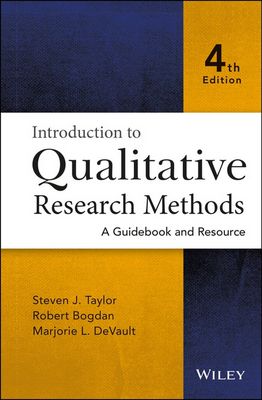Introduction to Qualitative Research Methods: A Guidebook and Resource
Námskeið FOM102F Eigindlegar rannsóknaraðferðir I - Höfundur: Steven J. Taylor, Robert Bogdan, Marjorie DeVault
10.690 kr.

Námskeið
- FOM102F Eigindlegar rannsóknaraðferðir I
Lýsing:
Introduction to Qualitative Research Methods offers practical advice, with examples, on how to conduct qualitative research. A hallmark feature is the inclusion of several complete qualitative studies conducted by the authors, along with their field notes. Readers can see how the authors, in actual studies, dealt with the methodological issues presented in the first chapters of the book. Most professors of introductory undergraduate and graduate courses want their students to read examples of qualitative studies.
Annað
- Höfundur: Steven J. Taylor, Robert Bogdan, Marjorie DeVault
- Útgáfa:4
- Útgáfudagur: 2015-09-03
- Hægt að prenta út 2 bls.
- Hægt að afrita 10 bls.
- Format:Page Fidelity
- ISBN 13: 9781118767306
- Print ISBN: 9781118767214
- ISBN 10: 1118767306
Efnisyfirlit
- Title Page
- Copyright
- Contents
- Acknowledgments
- Part 1 Among the People: How to Conduct Qualitative Research
- Chapter 1 Introduction: Go to the People
- A Note on the History of Qualitative Methods
- Qualitative Methodology
- Theory and Methodology
- Notes
- Chapter 2 Research Design and Pre-Fieldwork
- Research Design
- Selecting Settings
- Obtaining Institutional Review Board Approval
- Writing Proposals
- Access to Organizations
- Access to Public and Quasi-Public Settings
- Access to Private Settings
- What Do You Tell Gatekeepers and Informants?
- Collecting Data About Obtaining Access
- Covert Research
- Chapter 3 Participant Observation: In the Field
- Entering the Field
- Negotiating Your Role
- Establishing Rapport
- Participation
- Key Informants
- Difficult Field Relations
- Forming Relationships
- Field Tactics
- Asking Questions
- Learning the Language
- Field Notes
- Boundaries of a Study
- Leaving the Field
- Triangulation
- Ethics in the Field
- Chapter 4 In-Depth Interviewing
- The Qualitative Interview
- Types of Interview Studies
- Choosing to Interview
- Selecting Informants
- Approaching Informants
- Understanding the Interview in Context
- Managing the Interview Situation
- Getting People to Talk About What Is Important to Them
- The Interview Guide
- Probing
- Cross-Checks
- Relations With Informants
- Recording Interviews
- Group Interviews
- The Interviewer's Journal
- Note
- Chapter 5 Montage: Discovering Methods
- Disrupting the "Commonsense World of Everyday Life'': Harold Garfinkel
- Qualitative Research as Autobiography
- Entering a World Without Words
- Personal Documents
- Picturing Disability
- Photography and Videotaping
- Official Records and Public Documents
- Historical and Archival Research
- Notes
- Chapter 6 Working With Data: Data Analysis in Qualitative Research
- Narratives: Descriptive and Theoretical Studies
- Building Theory
- Working With Data
- Constructing Life Histories
- Chapter 1 Introduction: Go to the People
- Chapter 7 Writing and Publishing Qualitative Studies
- What You Should Tell Your Readers
- Some Tips on Writing
- Common Mistakes in Writing From Qualitative Data
- Publishing Qualitative Studies
- Selected Studies
- Chapter 8 "You're Not a Retard, You're Just Wise'': Disability, Social Identity, and Family Networks
- The Duke Family
- The Study
- Disability Labels and Family Constructions
- Social Identities
- Conclusion
- Notes
- References
- Chapter 9 Producing Family Time: Practices of Leisure Activity Beyond the Home
- Methods and Data
- Findings
- Discussion: Family as Socially Organized Practice
- Notes
- References
- Chapter 10 Ethnicity and Expertise: Racial-Ethnic Knowledge in Sociological Research
- Method
- Analysis
- Discussion
- Notes
- References
- Chapter 11 Citizen Portraits: Photos of People With Disabilities as Personal Keepsakes
- Settings
- Hiding Disability
- Conclusions
- Notes
- References
- Chapter 12 "They Asked for a Hard Job'': World War II Conscientious Objectors on the Front Lines
- Note
- References
UM RAFBÆKUR Á HEIMKAUP.IS
Bókahillan þín er þitt svæði og þar eru bækurnar þínar geymdar. Þú kemst í bókahilluna þína hvar og hvenær sem er í tölvu eða snjalltæki. Einfalt og þægilegt!Rafbók til eignar
Rafbók til eignar þarf að hlaða niður á þau tæki sem þú vilt nota innan eins árs frá því bókin er keypt.
Þú kemst í bækurnar hvar sem er
Þú getur nálgast allar raf(skóla)bækurnar þínar á einu augabragði, hvar og hvenær sem er í bókahillunni þinni. Engin taska, enginn kyndill og ekkert vesen (hvað þá yfirvigt).
Auðvelt að fletta og leita
Þú getur flakkað milli síðna og kafla eins og þér hentar best og farið beint í ákveðna kafla úr efnisyfirlitinu. Í leitinni finnur þú orð, kafla eða síður í einum smelli.
Glósur og yfirstrikanir
Þú getur auðkennt textabrot með mismunandi litum og skrifað glósur að vild í rafbókina. Þú getur jafnvel séð glósur og yfirstrikanir hjá bekkjarsystkinum og kennara ef þeir leyfa það. Allt á einum stað.
Hvað viltu sjá? / Þú ræður hvernig síðan lítur út
Þú lagar síðuna að þínum þörfum. Stækkaðu eða minnkaðu myndir og texta með multi-level zoom til að sjá síðuna eins og þér hentar best í þínu námi.
Fleiri góðir kostir
- Þú getur prentað síður úr bókinni (innan þeirra marka sem útgefandinn setur)
- Möguleiki á tengingu við annað stafrænt og gagnvirkt efni, svo sem myndbönd eða spurningar úr efninu
- Auðvelt að afrita og líma efni/texta fyrir t.d. heimaverkefni eða ritgerðir
- Styður tækni sem hjálpar nemendum með sjón- eða heyrnarskerðingu
- Gerð : 208
- Höfundur : 8654
- Útgáfuár : 2015
- Leyfi : 379


